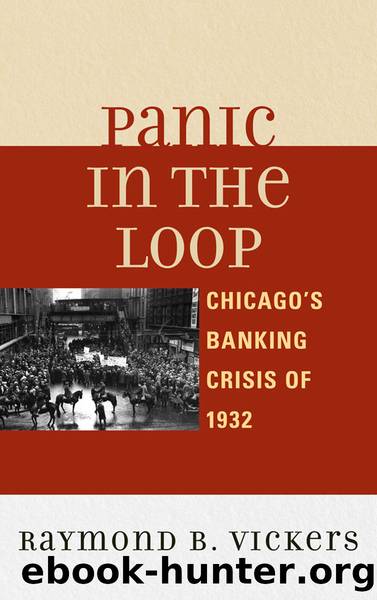Panic in the Loop by Vickers Raymond B

Author:Vickers, Raymond B.
Language: eng
Format: epub
ISBN: 9780739166420
Publisher: Lexington Books, a division of Rowman & Littlefield Publishers, Inc.
The comptrollerâs office had known for years that the officers and directors of the Bowmanville National Bank were abusing their fiduciary positions. In April 1930, Deputy Comptroller John L. Proctor had criticized management for the âunsatisfactory conditions and policiesâ of the bank, especially the âunwarrantedâ and excessive loans granted to John A. Schmidt, a bank director, in violation of federal law. The comptrollerâs office had been aware, specifically, of the illegal loans to officers and directors of the bank since at least 1928. By early 1930, the insider loans exceeded 10 percent of all loans and represented nearly the bankâs entire capital. Still, the comptrollerâs office failed to force the resignations of the officers or directors, preferring instead to admonish them privately. Regulators also allowed the directors to issue dividends, which depleted the bankâs meager capital and deceived the public about its true condition. Because of the extreme secrecy cloaking the comptrollerâs office, the public was unaware of the illegal activities at the bank.42
In addition to the insider abuses, most of the loans of the bank were secured with dubious real estate mortgages. By September 1931, federal examiners were reporting that officers and directors of the bank had made âliberal use of the funds and many of these loans are now found to be of questionable value.â The bank was in such a âhighly unsatisfactoryâ condition that examiners in the field balked at certifying its solvency. They reported to Washington that there was âabsolutely no hope for corrective measures from [the] present board of directors.â Frustrated examiners observed, âWhile this bank occupies a very desirable location and one that should be continued if possible, it remains that the directors as a whole are badly involved.â They concluded that âa continued drain on the deposits is gradually bringing the situation to a point where a suspension will be necessary.â
Yet the comptrollerâs office refused to take decisive action to limit depositorsâ losses. Deputy Comptroller Proctor merely wrote a letter complaining that the bank held âa menacing aggregate of slow and doubtful assetsâ totaling significantly more than twice the bankâs capital. Proctor issued a dead-letter warning to the board of directors that the bank was in âa most unsatisfactory condition.â Management flagrantly ignored regulators and did not even bother to require collateral or financial statements from one another as they continued to fund their own pet projects with depositorsâ money. Refusing to remove management or close the bank, submissive senior regulators in Washington allowed the plunder to continue unabated while depositorsâ losses mounted.43
On June 11, 1932, John P. OâShaughnessy, vice president and director, and Elmer A. Suckow, cashier, of the Bowmanville National Bank, met in Washington with Deputy Comptroller Proctor to discuss the crisis at the bank. The two promoter-bankers, who had defaulted on their own loans at the bank, told Proctor that the institution could be saved if it received an additional loan from the RFC. And they said they needed further âleniency on the part of [the comptrollerâs office] and its representatives in Chicago.
Download
This site does not store any files on its server. We only index and link to content provided by other sites. Please contact the content providers to delete copyright contents if any and email us, we'll remove relevant links or contents immediately.
International Integration of the Brazilian Economy by Elias C. Grivoyannis(90559)
The Radium Girls by Kate Moore(11921)
Turbulence by E. J. Noyes(7935)
Nudge - Improving Decisions about Health, Wealth, and Happiness by Thaler Sunstein(7612)
The Black Swan by Nassim Nicholas Taleb(7009)
Rich Dad Poor Dad by Robert T. Kiyosaki(6397)
Pioneering Portfolio Management by David F. Swensen(6226)
Man-made Catastrophes and Risk Information Concealment by Dmitry Chernov & Didier Sornette(5921)
Zero to One by Peter Thiel(5684)
Secrecy World by Jake Bernstein(4639)
Millionaire: The Philanderer, Gambler, and Duelist Who Invented Modern Finance by Janet Gleeson(4373)
The Age of Surveillance Capitalism by Shoshana Zuboff(4207)
Skin in the Game by Nassim Nicholas Taleb(4161)
Bullshit Jobs by David Graeber(4093)
The Money Culture by Michael Lewis(4073)
Skin in the Game: Hidden Asymmetries in Daily Life by Nassim Nicholas Taleb(3929)
The Dhandho Investor by Mohnish Pabrai(3698)
The Wisdom of Finance by Mihir Desai(3649)
Blockchain Basics by Daniel Drescher(3495)
